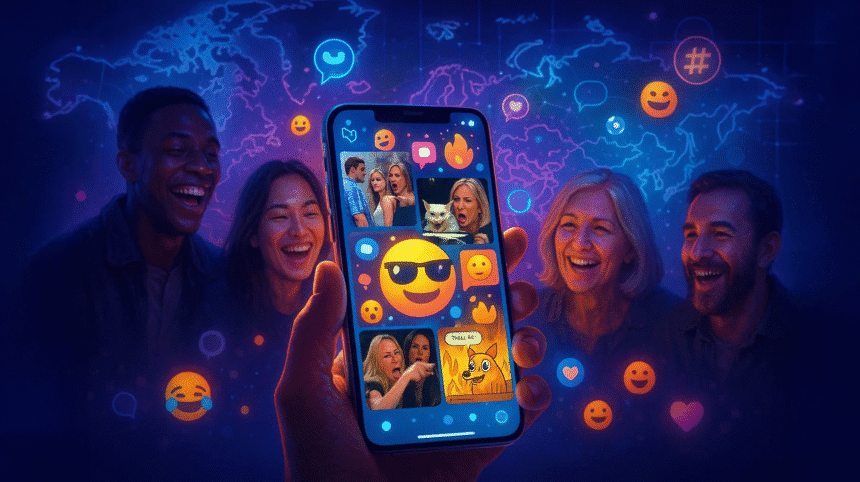In a world where a picture can speak a thousand words, memes have emerged as one of the most powerful tools of modern communication. What began as lighthearted online humor has evolved into a universal language that transcends cultures, countries, and even languages. From influencing political movements to shaping brand identities, memes are no longer just internet jokes; they are digital expressions of emotion, commentary, and connection.
The story of memes dates back much earlier than social media. The term “meme” was first coined in 1976 by evolutionary biologist Richard Dawkins in his book The Selfish Gene, describing it as an idea that spreads and evolves across cultures, much like genes in the biological world. However, the digital form of memes began to take shape in the late 1990s, when early internet forums like 4chan and Something Awful gave rise to viral images such as the Dancing Baby (1996) and Hamster Dance (1998). These quirky visuals marked the birth of a new communication era, one driven by humor, relatability, and speed.
The 2000s witnessed an explosion of meme culture with the rise of social media platforms like Facebook, Reddit, and Twitter, and later TikTok and Instagram. As sharing became easier, memes transformed from static images to looping GIFs, short videos, and viral sound clips. In 2025, memes have become the emotional shorthand of digital life, capable of expressing complex ideas or collective moods in seconds. A meme can summarize frustration, joy, irony, or even political critique more efficiently than a paragraph of text.
Why do memes work so well? In today’s attention-driven online world, users crave fast, engaging, and emotionally resonant content. Memes succeed because they are simple yet layered; they can make people laugh while conveying serious undertones. According to a 2024 Pew Research survey, 78% of internet users aged 16–35 share memes at least once a week, while over 60% say memes help them express their feelings more effectively than words. Humor, relatability, and the power of shared experience make memes an essential part of online identity and communication.
Modern communication has undergone a radical transformation due to memes. They have become a new form of storytelling and even activism. In politics, for instance, memes have mobilized communities and fueled movements. The “Bernie Sanders in Mittens” meme during the 2021 U.S. inauguration became a global symbol of humor and political commentary, while pandemic-era memes helped people cope with isolation and uncertainty. From poking fun at remote work struggles to toilet paper shortages, humor became a survival mechanism during a global crisis.
Brands have also recognized the communicative power of memes. Companies like Netflix, Wendy’s, and Duolingo use memes as marketing tools to connect with younger audiences in authentic ways. A clever meme can instantly go viral, earning brands millions of impressions without traditional advertising. Memes make corporate communication more human, conversational, and relevant.
Several memes have defined the digital age. Distracted Boyfriend (2017) captured the essence of temptation and shifting attention; Woman Yelling at a Cat (2019) perfectly illustrated online arguments; This Is Fine (2013) became the face of calm denial amid chaos; and How It Started vs. How It’s Going (2020) reflected personal and societal transformation. Each of these viral creations encapsulates the spirit of its time, serving as both entertainment and social commentary.
Globally, memes have blurred cultural boundaries. A joke about Monday blues or exam stress can be understood in any language. From India’s Bollywood-inspired memes to Japan’s anime-based humor, each region adapts memes to local tastes while maintaining their universal appeal. Researchers now describe memes as a form of digital folklore: a living, evolving narrative that documents the thoughts, fears, and humor of the internet generation. Even educators are adopting memes to explain complex concepts, using humor as a bridge between information and engagement.
As technology advances, meme-making is becoming increasingly sophisticated. Artificial intelligence is now generating memes, creating humor that mimics human wit. While AI-generated memes raise questions about authenticity, they highlight how digital expression continues to evolve. Yet, at its heart, meme culture remains deeply human; it thrives on shared emotion, creativity, and the universal desire to connect.
Memes are not replacing traditional communication; they are reshaping it. They turn global conversations into shared laughter and complex realities into relatable moments. In 2025, understanding culture means understanding memes. To know what the world is thinking or feeling, you no longer need to read between the lines; you just need to scroll through the memes.




















